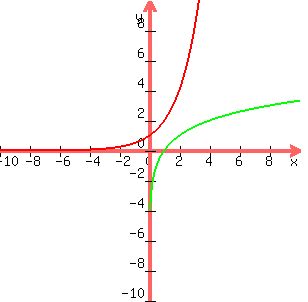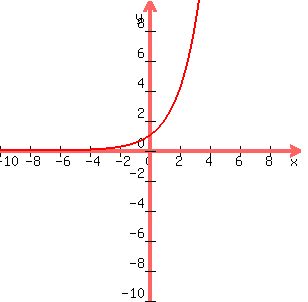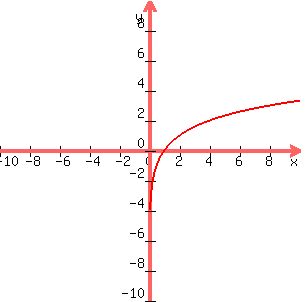Question 212950: y = 2^x x = 2^y
Evaluate the exponential equation for three positive values of x, three negative values of x, and x =0. Transform the second expression into the equivalent logarithmic equation; and evaluate the logarithmic equation for three values of x that ar greater than 1, three values of x that are between 0 and 1, and at x = 1. Use the resulting ordered pairs to plot the graph of each function.
On the first equation I got y = 2^x
X Y 3 positives of x
1 2
2 4
3 8
X Y 3 negatives of x
-1 -2
-2 -4
-3 -8
X Y x = 0
0 2
I do not under stand the second part of this equation. Is the first part correct?
Found 2 solutions by rapaljer, Theo:
Answer by rapaljer(4671)   (Show Source): (Show Source):
You can put this solution on YOUR website! No! For y=2^x, when you use negative values for x, you do NOT get negative values for y! What you get is a fraction!
y=2^x
If x=-1, then y=2^-1 = 1/2
if x=-2, then y=2^-2 =1/4
If x=-3, then y=2^-3=1/8
Then the second part of the equation seems strange to me. Let me take a look at it. (You may find my explanation that I referenced below helpful for this part!)
Start with x=2^y, and change it to logarithmic form. In this case, 2 is the base number, y is the exponent, and x is the result. You can write this in logarithmic form as  , so , so  . .
Now, you are supposed to take 3 values of x that are greater than 1 (like x=2, 4, and 8, which would give you 3 values of y that are 1,2, and 3 respectively). I don't know if how I got these numbers is clear to you, but that's what they want you to do!
Then take 3 values of x that are between 0 and 1 (like x=1/2, 1/4, and 1/8, which give you values of y that are -1, -2, and -3 respectively).
If you graph these points, I suppose it should look like this:

See if that makes any sense to you!!
You might want to look at my own explanation of LOGARITHMS in which I begin my explanation with the graphs of y=2^x compared to x=2^y. I did a video a few years ago, and it is on my website for free if you want to see it. Do a "Bing" search for my last name "Rapalje", and look for "Rapalje Homepage." Near the top of my Homepage, I have a link called "Rapalje Videos". Click on that and choose "College Algebra". Look for the two videos on Logarithms. This would be the first one.
I also have my written explanation of Logarithms. From the top of my homepage, look for "Basic, Intermediate, and College Algebra: One Step at a Time", choose "College Algebra" and look for "Chapter 4, Logarithms." This is my own non-traditional explanation written for students who don't understand the traditional textbooks.
It might help you, and it's ALL free, like algebra.com!
R^2
Dr. Robert J. Rapalje, Retired
Seminole Community College
Altamonte Springs Campus
Florida
Answer by Theo(13342)   (Show Source): (Show Source):
You can put this solution on YOUR website! y = 2^x x = 2^y
Evaluate the exponential equation for three positive values of x, three negative values of x, and x =0. Transform the second expression into the equivalent logarithmic equation; and evaluate the logarithmic equation for three values of x that ar greater than 1, three values of x that are between 0 and 1, and at x = 1. Use the resulting ordered pairs to plot the graph of each function.
-----
FIRST EQUATION
-----

x is the exponent, 2 is the base.
-----
when x is positive:



-----
when x is negative:



-----
graph of y = 2^x is shown below:

-----
SECOND EQUATION
-----

y is the exponent, 2 is the base.
-----
when y is positive:



-----
when y is negative:



-----
You cannot graph this directly since the graphs are set up so that the independent variable is x and the dependent variable is y.
-----
In order to graph this, you have to solve for y.
-----
Your equation is:

-----
The basic definition of an exponential equation is:
 if and only if if and only if 
When you reverse the x and y like we have in this second form of the exponential equation, then the basic definition becomes:
 if and only if if and only if 
-----
Your equation is:

-----
By the basic definition of exponents,  if and only if if and only if 
-----
The graph of  is shown below: is shown below:
-----

-----
 is the inverse equation of is the inverse equation of 
You derive the inverse equation by doing exactly what they are asking you to do when they showed you the two equations.
-----
In order to find the inverse equation of  you would do the following: you would do the following:
-----
Solve for x:
-----
By the basic definition of exponents,  if and only if if and only if 
-----
You have just solved for x by just applying the basic definition of exponents.
-----
You have:

-----
Next you transpose the x and the y in the equation.
Your equation becomes:

-----
 is the inverse equation of is the inverse equation of 
-----
You have just derived the inverse equation of  . That equation is . That equation is 
-----
The inverse equation is the reflection of the normal equation about the line y = x.
The following graph shows the normal equation of  and the inverse equation of and the inverse equation of  and the line and the line 
-----

-----
If you draw a perpendicular line anywhere through the line y = x, the intersection of that line through  will be (a,b), and the intersection of that line through will be (a,b), and the intersection of that line through  will be (b,a). will be (b,a).
-----
for example:
when x = 2,  = 4 so the coordinates are (2,4) = 4 so the coordinates are (2,4)
when x = 4,  = 2 so the coordinates are (4,2) = 2 so the coordinates are (4,2)
-----
The equation of the line perpendicular to the line y = x and passing through the points (2,4) and (4,2) is y = -x + 6.
-----
Adding that line to the graph of the 3 equations yields the following:
-----

-----
As you can see, the two points intersecting with the line perpendicular to the line y = x are the same distance from that line making the two graphs symmetric to each other about the line y = x.
-----
|
|
|